| Weight | 1 lbs |
|---|---|
| Dimensions | 9 × 5 × 2 in |
| host | mouse |
| isotype | IgG1 |
| clonality | monoclonal |
| concentration | concentrate, predilute |
| applications | IHC |
| reactivity | human |
| available size | 0.1 mL, 0.5 mL, 1 mL concentrated, 7 mL prediluted |
mouse anti-MUC-2 monoclonal antibody (Ccp58) 6266
Price range: $160.00 through $528.00
Antibody summary
- Mouse monoclonal to MUC-2
- Suitable for: Immunohistochemistry (formalin-fixed, paraffin-embedded tissues)
- Reacts with: Human
- Isotype:IgG1
- Control: Colon carcinoma
- Visualization: Cell membrane
- 0.1, 0.5, 1.0 mL concentrated, 7 mL prediluted
mouse anti-MUC-2 monoclonal antibody Ccp58 6266
| target relevance |
|---|
| Protein names Mucin-2 (MUC-2) (Intestinal mucin-2) |
| Gene names MUC2,MUC2 SMUC |
| Mass 550850Da |
| Function FUNCTION: Coats the epithelia of the intestines and other mucus membrane-containing organs to provide a protective, lubricating barrier against particles and infectious agents at mucosal surfaces (PubMed:17058067, PubMed:19432394, PubMed:33031746). Major constituent of the colon mucus, which is mainly formed by large polymeric networks of MUC2 secreted by goblet cells that cover the exposed surfaces of intestine (PubMed:19432394, PubMed:33031746). MUC2 networks form hydrogels that guard the underlying epithelium from pathogens and other hazardous matter entering from the outside world, while permitting nutrient absorption and gas exchange (PubMed:33031746, PubMed:36206754). Acts as a divalent copper chaperone that protects intestinal cells from copper toxicity and facilitates nutritional copper unptake into cells (PubMed:36206754). Binds both Cu(2+) and its reduced form, Cu(1+), at two juxtaposed binding sites: Cu(2+), once reduced to Cu(1+) by vitamin C (ascorbate) or other dietary antioxidants, transits to the other binding site (PubMed:36206754). MUC2-bound Cu(1+) is protected from oxidation in aerobic environments, and can be released for nutritional delivery to cells (PubMed:36206754). Mucin gels store antimicrobial molecules that participate in innate immunity (PubMed:33031746). Mucin glycoproteins also house and feed the microbiome, lubricate tissue surfaces, and may facilitate the removal of contaminants and waste products from the body (PubMed:33031746). Goblet cells synthesize two forms of MUC2 mucin that differ in branched chain O-glycosylation and the site of production in the colon: a (1) 'thick' mucus that wraps the microbiota to form fecal pellets is produced in the proximal, ascending colon (By similarity). 'Thick' mucus transits along the descending colon and is lubricated by a (2) 'thin' MUC2 mucus produced in the distal colon which adheres to the 'thick' mucus (By similarity). {ECO:0000250|UniProtKB:Q80Z19, ECO:0000269|PubMed:17058067, ECO:0000269|PubMed:19432394, ECO:0000269|PubMed:33031746, ECO:0000269|PubMed:36206754}. |
| Subellular location SUBCELLULAR LOCATION: Secreted {ECO:0000269|PubMed:33031746}. Note=In the intestine, secreted into the inner and outer mucus layers (By similarity). Before secretion, mucin polymers are stored in dedicated secretory vesicles (PubMed:33031746). {ECO:0000250|UniProtKB:Q80Z19, ECO:0000269|PubMed:33031746}. |
| Tissues TISSUE SPECIFICITY: Colon, small intestine, colonic tumors, bronchus, cervix and gall bladder. {ECO:0000269|PubMed:8300571}. |
| Structure SUBUNIT: Homomultimer; disulfide-linked (PubMed:12374796, PubMed:31310764, PubMed:33031746, PubMed:35377815). The N- and C-terminus mediate their assembly into higher order structures to form filaments (PubMed:33031746, PubMed:35377815). The CTCK domains of two polypeptides associate in the endoplasmic reticulum to generate intermolecularly disulfide-bonded dimers (By similarity). These dimers progress to the Golgi apparatus, which is a more acidic environment than the endoplasmic reticulum (PubMed:33031746). Under acidic conditions, the N-termini form non-covalent intermolecular interactions that juxtapose assemblies of the third VWD domain (VWD3) from different CTCK-linked dimers (PubMed:33031746). The VWD3 assemblies then become disulfide bonded to one another to produce long, disulfide-linked polymers that remain highly compact until secretion (PubMed:33031746). Interacts with FCGBP (PubMed:19432394). Interacts with AGR2; disulfide-linked (PubMed:19359471). {ECO:0000250|UniProtKB:Q9HC84, ECO:0000269|PubMed:12374796, ECO:0000269|PubMed:19359471, ECO:0000269|PubMed:19432394, ECO:0000269|PubMed:31310764, ECO:0000269|PubMed:33031746, ECO:0000269|PubMed:35377815}.; SUBUNIT: (Microbial infection) Interacts in vitro with L.monocytogenes internalin proteins InlB, InlC and InlJ; for InlC binding is slightly better at pH 5.5, (the pH of the intestine) than at pH 7.4. {ECO:0000269|PubMed:18327567}. |
| Post-translational modification PTM: O-glycosylated (PubMed:11445551, PubMed:33031746). O-glycosylation is required for mucin assembly (PubMed:33031746). Goblet cells synthesize two forms of mucin that differ in branched chain O-glycosylation and the site of production in the colon (By similarity). {ECO:0000250|UniProtKB:Q80Z19, ECO:0000269|PubMed:11445551, ECO:0000269|PubMed:33031746}.; PTM: May undergo proteolytic cleavage in the outer mucus layer of the colon, contributing to the expanded volume and loose nature of this layer which allows for bacterial colonization in contrast to the inner mucus layer which is dense and devoid of bacteria. {ECO:0000250|UniProtKB:Q80Z19}.; PTM: At low pH of 6 and under, undergoes autocatalytic cleavage in vitro in the N-terminal region of the fourth VWD domain. It is likely that this also occurs in vivo and is triggered by the low pH of the late secretory pathway. {ECO:0000269|PubMed:12582180}. |
| Domain DOMAIN: The CTCK domain mediates interchain disulfide bonds with another molecule of MUC2. {ECO:0000250|UniProtKB:Q9HC84}. |
| Target Relevance information above includes information from UniProt accession: Q02817 |
| The UniProt Consortium |
Data
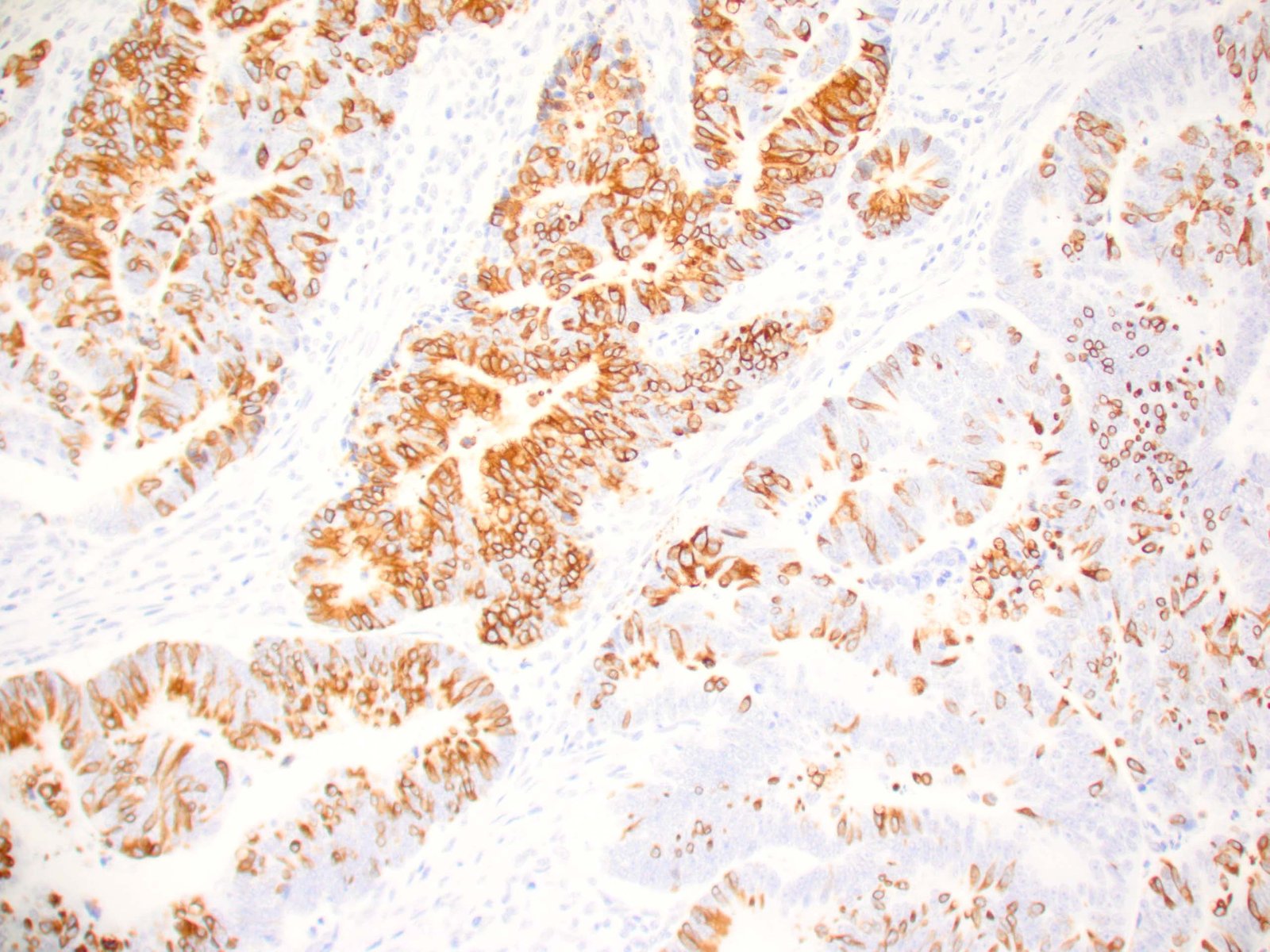 |
| Human colon adenocarcinoma stained with anti-MUC-2 antibody using peroxidase-conjugate and DAB chromogen. Note the cytoplasmic staining of tumor cells. |
Publications
| pmid | title | authors | citation |
|---|---|---|---|
| We haven't added any publications to our database yet. | |||
Protocols
| relevant to this product |
|---|
| IHC |
Documents
| # | SDS | Certificate | |
|---|---|---|---|
| Please enter your product and batch number here to retrieve product datasheet, SDS, and QC information. | |||
Only logged in customers who have purchased this product may leave a review.

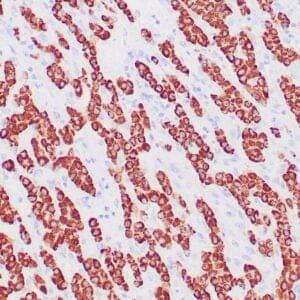
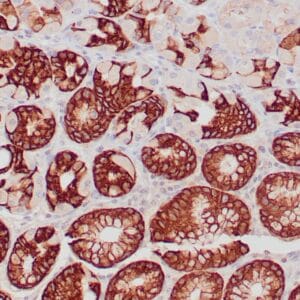
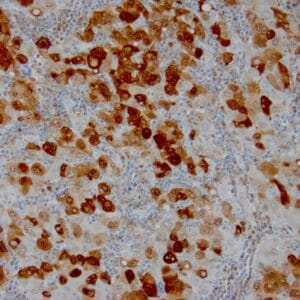
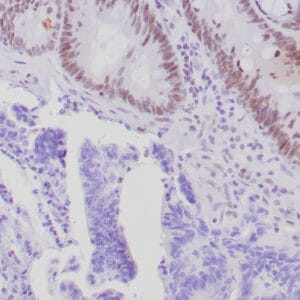
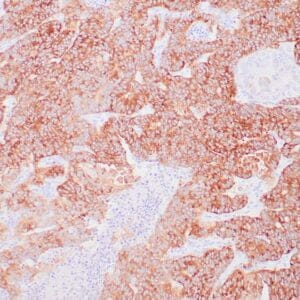
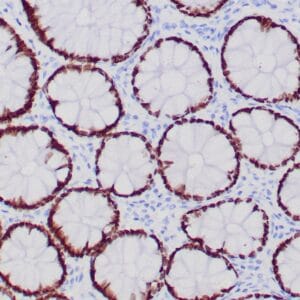

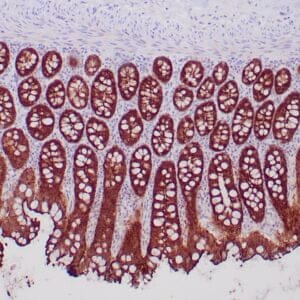
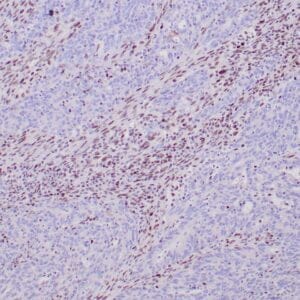
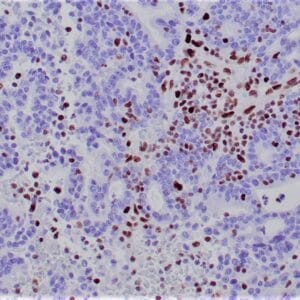
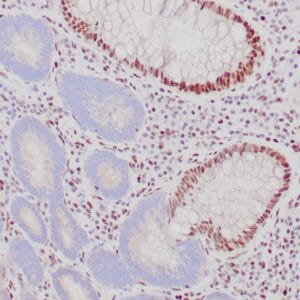
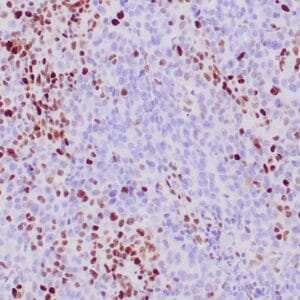
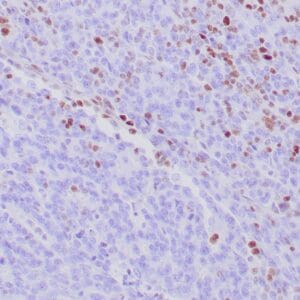

Reviews
There are no reviews yet.